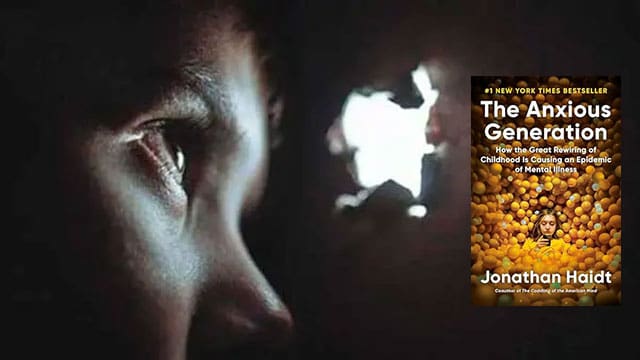In his new book The Anxious Generation, Jonathan Haidt examines the rise in mental health challenges faced by Generation Z

For interview requests, click here
Jonathan Haidt is an American social psychologist with a flair for writing provocative books that reach a large audience. The Righteous Mind (2012) is probably the most prominent example, but The Coddling of the American Mind (co-written in 2018 with Greg Lukianoff) isn’t far behind. Haidt is now back with another offering.
The Anxious Generation is about the population cohort born after 1995, the group that’s often referred to as Gen Z. Citing data on steeply rising levels of anxiety, depression and self-harm, Haidt identifies two primary contributors.
One is the advent of social media and the ubiquitous smartphone, which transformed childhood/adolescence from play-based to phone-based. And the other is the shift in parenting styles towards what he characterizes as safetyism.
Although Haidt’s concerns about social media addiction sound plausible, it’s something I have no personal sense for. Parenting styles are a different matter.
Growing up in Ireland during the 1950s meant a childhood where play entailed virtually no adult supervision. If you weren’t in school and it wasn’t raining, the virtues of daytime fresh air and physical exercise meant that you were expected to get out of the house and not reappear until mealtimes. Who you played with and how you played was left entirely up to you.
 |
| Recommended |
| The love affair that shaped the First World War
|
| What we can learn from the fall of Carthage
|
| Treasure Island’s ripping adventure stands the test of time
|
As for going to school, nobody took you there or picked you up. You used public transport and navigated busy street crossings. And neither school nor subsequent university had any conception of safe spaces or trigger warnings. The demand to be shielded from disagreeable people or ideas would’ve been considered absurd.
My wife’s Canadian upbringing in East York and Mississauga followed roughly similar lines, albeit perhaps with a little less adventure than mine. Childhoods like ours were considered normal back then. Nowadays, though, they might get parents into trouble.
Haidt traces the change to a trend that started in the 1980s and substantially accelerated in the 1990s. Parenting became more protective and fearful, with a corresponding diminution in free play. Consequently, the “small-scale challenges and setbacks” that function “like an inoculation” preparing children for life’s greater challenges were either significantly reduced or disappeared entirely.
In Haidt’s view, free play is a necessity for development. It’s “the way children naturally develop social skills, overcome anxiety, and become self-governing young adults.” Play should even have an element of physical risk. Exposure to the possibility of minor injuries is a feature, not a bug.
Defining acceptable risk is necessarily a subjective exercise. As an approximate rule of thumb, Haidt quotes the University of British Columbia’s Mariana Brussoni to the effect that playgrounds should be designed to “keep them as safe as necessary, not as safe as possible.”
Haidt describes the human brain as having two subsystems. There’s discover mode and defend mode. And children born after 1995 are more likely to default to the latter.
Discover mode habituates a child to look at the world positively. It’s a place to search out opportunities and think for yourself. If a single phrase can encapsulate attitude, it would be let me grow!
Defend mode sees the world from a different perspective. Rather than opportunity, it’s a place of danger. And the underlying attitudinal descriptor is keep me safe!
There are, of course, real dangers in the world and times when defend mode is completely appropriate. But, in Haidt’s view, a person who spends most of their time in that frame of mind is likely to learn less and grow less.
He sees the effects of this in the change that appeared around 2014 when the first members of Gen Z arrived on campus. To quote: “The only disorders that rose rapidly were psychological disorders … overwhelmingly anxiety and depression.” And he attributes it, at least in part, to a generation being raised in an environment of parental safetyism.
There’s also a riff on Lebanese-American essayist, scholar, statistician, and former options trader Nassim Taleb’s concept of antifragility. In Taleb’s telling, fragility refers to “things that are vulnerable to volatility” whereas antifragility implies being able to “gain from volatility, variability, stress and disorder.” You don’t have to be a rocket scientist to figure out which quality is preferable.
Haidt believes that children are naturally antifragile. He puts it this way: “Just as the immune system must be exposed to germs, and trees must be exposed to wind, children require exposure to setbacks, failures, shocks, and stumbles in order to develop strength and self-reliance.”
While you don’t have to buy Haidt’s entire thesis, consideration is useful. After all, resilience is a virtue worth cultivating.
Troy Media columnist Pat Murphy casts a history buff’s eye at the goings-on in our world. Never cynical – well, perhaps a little bit.
Explore more on Parenting, Child care, Psychology
Troy Media is committed to empowering Canadian community news outlets by providing independent, insightful analysis and commentary. Our mission is to support local media in building an informed and engaged public by delivering reliable content that strengthens community connections, enriches national conversations, and helps Canadians learn from and understand each other better.
